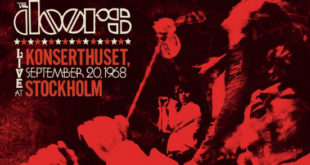Septuagenarian trumpet jazz master Eddie Henderson’s Collective Portrait was the February release in the monthly series inaugurated last year by Smoke Sessions Records, and like nearly every album in the series, it is a winner. Age has not dimmed Henderson. If anything, like a great wine, it has enriched his playing. Like many a fine musician, he has never garnered the kind of popular fame his playing certainly deserved, but over the years he has consistently delivered the goods playing with some very well-known jazz names—most notably Herbie Hancock and Art Blakey.
Often compared to the great Miles Davis for his lyrical prowess, Henderson chose the title for his new album from a Davis quip defining the collaborative essence of the best jazz: “A collective portrait is better than a self-portrait.” Also pointing out the care that Davis would take in choosing compatible musicians to work with, he chose side men that he had worked with over the years, side men with chemistry. George Cables plays piano and Rhodes, Doug Weiss, bass and Carl Allen is on drums. Gary Bartz plays alto saxophone on six of the album’s 10 songs. Together they have come up with one fine album, one that like some of the others in the Smoke Sessions series, has been at the top of The Cool Jazz Countdown.
The set opens with two original pieces, “Sunburst” and “Dreams,” and adds two by Cables, “Morning Song” and “Beyond Forever,” all revisiting earlier recorded material. He includes a number of songs by musicians he considers his mentors, teachers and friends: Freddie Hubbard’s “First Light,” Jimmy Heath’s “Ginger Bread Boy” which he first heard on Miles Smiles, and Woody Shaw’s “Zoltan.”
 But perhaps the highlights of the album are the lyrical ballads (with apologies to Wordsworth). Pianist Duke Pearson’s “You Know I Care” is a sonic romance, while Henderson’s wife Natsuko’s song “Together” is a tender, melodious tribute to their years, you guessed it, together. Ballads demand a sensitive touch, else they melt into sentimental schmaltz – the latter doesn’t occur from the horn of Henderson, not to my ear.
But perhaps the highlights of the album are the lyrical ballads (with apologies to Wordsworth). Pianist Duke Pearson’s “You Know I Care” is a sonic romance, while Henderson’s wife Natsuko’s song “Together” is a tender, melodious tribute to their years, you guessed it, together. Ballads demand a sensitive touch, else they melt into sentimental schmaltz – the latter doesn’t occur from the horn of Henderson, not to my ear.
The album liner notes consist of Damon Smith’s interview with Henderson and are filled with interesting biographical material, including Henderson’s childhood visit backstage at the Apollo theater to meet Louis Armstrong, his teenage prowess as a figure skater, and his pursuit of a medical degree eventually specializing in and practicing psychiatry. Eddie Henderson is the very model of the Renaissance man.
[amazon template=iframe image&asin=B00R84VZ50]
 Blogcritics The critical lens on today's culture & entertainment
Blogcritics The critical lens on today's culture & entertainment



